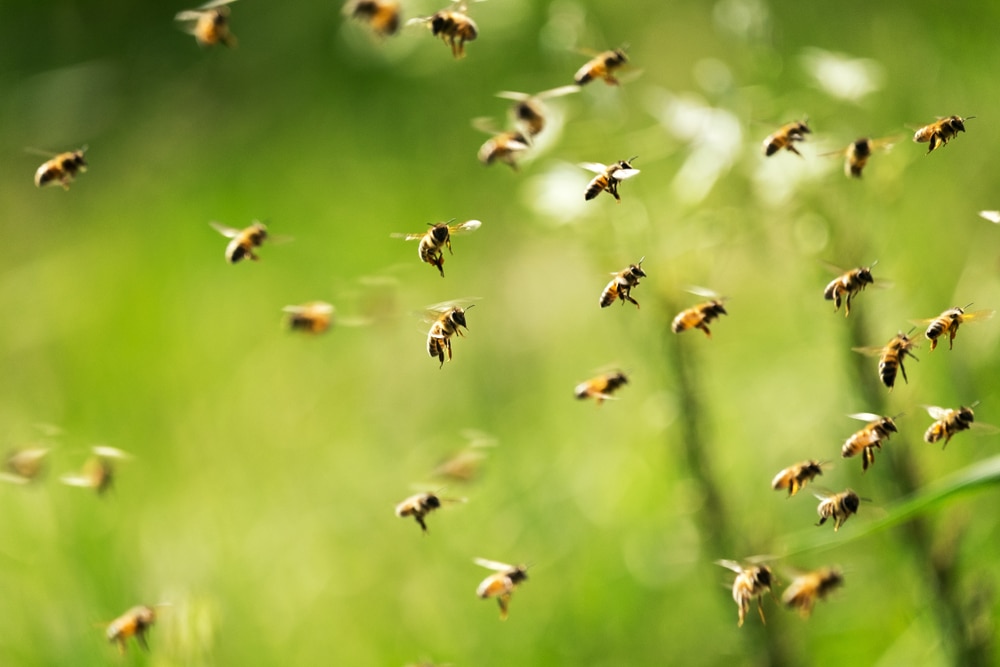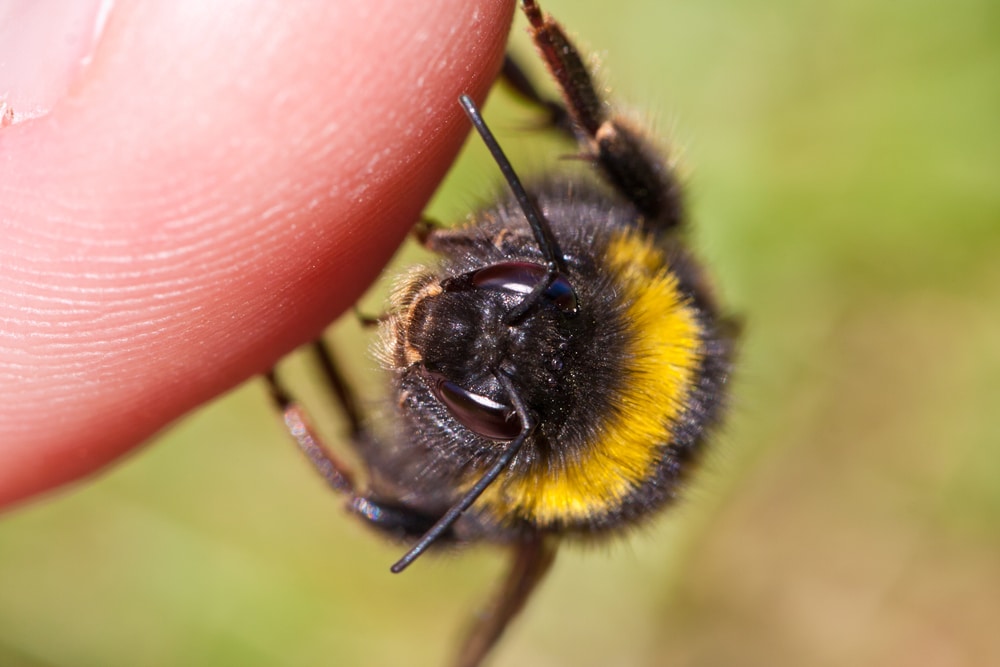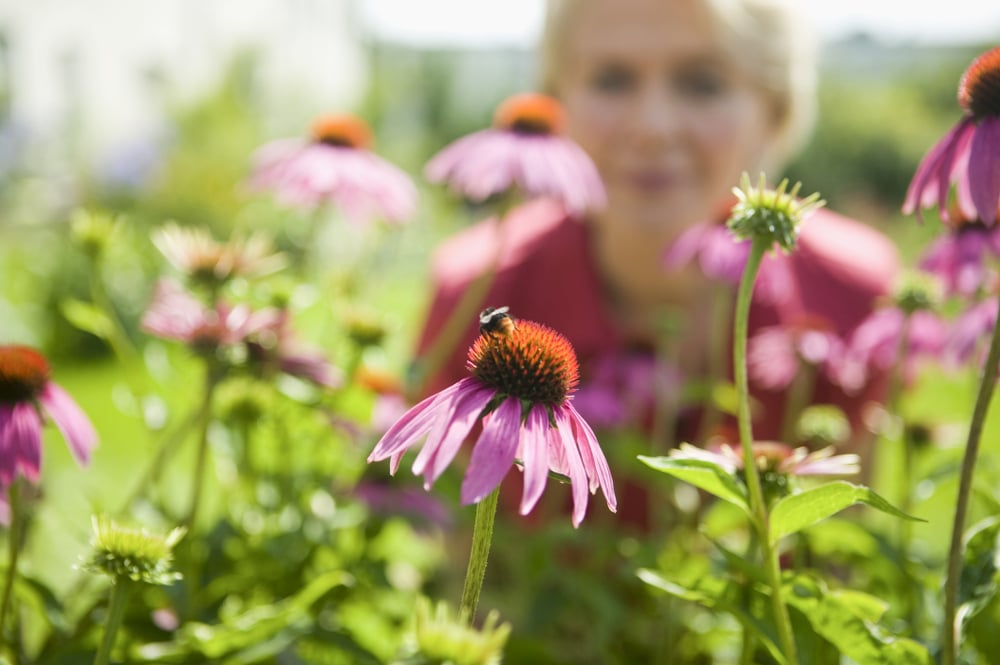Many people run away in horror when confronted with a bee. We know these insects can sting, and I understand that nobody wants to be on the receiving end. But if we can understand why bees sting, we can better avoid being their target. So, why do bees sting?
Most bees sting only when they feel threatened. Otherwise, they are docile. Only Africanized honey bees are aggressive.
Do All Bees Sting?

Not all bee species are capable of stinging. In fact, it’s estimated there are around 550 species of completely stingless bees.
What’s more, some of the most common bee visitors to your garden only have stingers if they’re female. This includes honey, bumble, carpenter, and sweat bees.
When you see a bee, one of the best things to do is to try to identify it.
This will enable you to determine whether it poses a sting risk. That said, even if you’re faced with a non-stinging species, it’s still best to leave it alone and let it go about its business.
Why Do Bees Sting?

Bees are generally docile insects and are all around, so you’re sure to encounter them. For the most part, you won’t get stung if you leave them alone because bees reserve their stings for when they feel they’re in danger.
Many bee species live in large colonies and work very closely as a team. One of the major roles of worker bees is to protect the queen and the nest, and they’ll go to any lengths to do this, including delivering a painful sting.
Male bees, which cannot sting, will usually buzz around you as a warning to leave them alone. This is especially true if you come too close to their nest.
Are Bees Aggressive?
There is one species, called the Africanized honey bee, that is known for its aggression. Not only are they more likely to sting even when unprovoked, but they’ll attack in large numbers. They’re often called “killer bees” because they have been known to cause fatalities.
However, other species of bees, including honey bees, mining bees, carpenter bees, bumblebees, and sweat bees, will only sting if threatened.
A bee could even land on you (which sweat bees commonly do), and as long as you don’t try to hurt it, it probably won’t sting.
As somebody that loves bees, it upsets me that they’ve got such a bad reputation. While their relatives, the wasps, are more likely to sting for the sake of it, most bees are gentle creatures. They just want to be left alone to collect nectar and pollen.
Do Bees Sting At Night?
Bees can sting no matter what time of day it is.
That said, while there are some crepuscular (active at dawn and dusk) and nocturnal (active at night) species of bees, most are active during the day.
Bees usually come out early in the morning and spend the day foraging, which is when you’re most likely to encounter them.
Once the sun starts to set and the temperature drops, they’ll retreat to their hive or nest. That’s why it’s very uncommon to see a bee at night. One main reason is that many bee species use the sun as part of their navigation system.
Furthermore, bees require particular conditions for flight, including the perfect temperature. This temperature can be between 72 and 77 degrees Fahrenheit (72ºF-74ºF or 22.22ºC-25ºC), but bees can fly in heat up to 100ºF (37.78ºC). At night, temperatures often fall below this.
Do Bees Die When They Sting?
You’ve probably been told at some point that a bee won’t sting you because it’ll die if it does.
There is some truth to this, but it only refers to one species: the honey bee. All other types of stinging bees are very much alive after they sting you.
The Horrible Truth About Honey Bees
One of the most fascinating things for me about honey bees is the gruesome death they face upon stinging.
As I’ve said, many people will tell you honey bees won’t sting because they’ll die. However, scientists firmly believe that the bee isn’t aware of its fate.
Nonetheless, this species is in for something of a shock if it decides that stinging is the only way to defend itself.
You see, honey bees have a barbed stinger. This fact means that when inserted into the flesh of a mammal, it becomes lodged. Imagine pulling a barbed fishing hook out, and you’ll get the idea.
Since the bee will still try to pull away, the stinger remains inside the target and is violently ripped from our buzzing friend’s body along with its abdomen. There’s no way the bee can survive this, so it faces almost immediate death.
That said, when honey bees sting, they release an alarm pheromone (a chemical used for communication), which attracts other bees to the scene. This technique is a way for bees to defend themselves as a colony. When the other bees turn up, they’re agitated and ready to sting if needed.
Are Bee Stings Poisonous?
Bees do produce venom, although, for most people, this venom causes nothing more than localized irritation and pain.
However, if you are stung by a honey bee and the stinger remains in your skin, removing it as quickly as possible is essential. Not doing so means it will release more venom, causing you more problems. Again, this is unlikely to be serious.
Bee venom can be fatal in large doses, though. According to experts, you would have to receive around 8.6 stings per pound of your body weight for it to result in death. For adults, this typically equates to approximately 1,000 bee stings. So, you’ll be safe unless you plan on disturbing thousands of bees at once (which we recommend not doing).
Bee Sting Allergies
While for most people, bee venom doesn’t cause anything more than minor symptoms; some have a bee sting allergy.
This allergy happens when your immune system mistakes the bee venom for something more serious and starts to attack it by releasing histamines (chemicals created by your body to throw out bad things).
When this happens, the symptoms can be much worse; in some cases, bee stings can result in death. This is why it’s incredibly important to seek treatment as soon as possible if you know or suspect you have an allergy. If you aren’t sure whether you’re having an allergic reaction, look for the following symptoms:
- Extreme swelling or redness at the sting site
- Swelling in the mouth and throat
- Difficulty breathing
- Gastrointestinal issues like nausea, vomiting, and diarrhea
- Dizziness
- Fainting
- Loss of consciousness
What To Do If You’re Stung By A Bee

Getting stung by a bee is never pleasant. It can be quite painful, and the swelling and redness may not subside for some days. However, the good news is this is usually something you can treat at home by doing the following:
- If the stinger is lodged in your skin, use a flat-edged object such as a credit card to scrape over the surface, which will remove the sting.
- Wash the area well with soap and warm water.
- Apply a cold press to the area to reduce swelling.
- Take over-the-counter pain medication.
If you have an allergic reaction, seeking medical attention as quickly as possible is vital. In severe cases, allergies may result in anaphylactic shock or even death.
How To Avoid Getting Stung By A Bee

There are more than 20,000 species of bees worldwide, so it’s challenging to keep away from them completely. They’re part of nature, and, for the most part, we have to live alongside them.
That said, there are some things you can do to reduce the risk of a bee stinging you, as well as keeping them away from your garden.
Here’s what you can do:
- Move Slowly Or Stay Still: You can gently brush the bee away, but avoid swatting, as this will make the bee feel threatened and more likely to sting.
- Use Natural Repellents: Use natural insect repellents like peppermint oil, citronella candles, or over-the-counter organic sprays.
- Avoid Wearing Heavily Scented Fragrances: Bees often mistake these for real flowers and may come to investigate.
- Avoid Wearing Bright Colors: Bees are especially attracted to blue, green, yellow, and purple, but they cannot see red.
- Cover Your Skin: Wear lightweight clothing covering as much skin as possible.
- Leave Nests Alone: I know observing bees is super exciting, but you shouldn’t get too close.
- Invest In Bee-Repelling Plants: Surround your patio or seating area with bee-repelling plants like mint, citronella, and eucalyptus.
- Cover Food And Drinks: If you’re eating outdoors, avoid leaving food and drink uncovered as this will attract bees.

